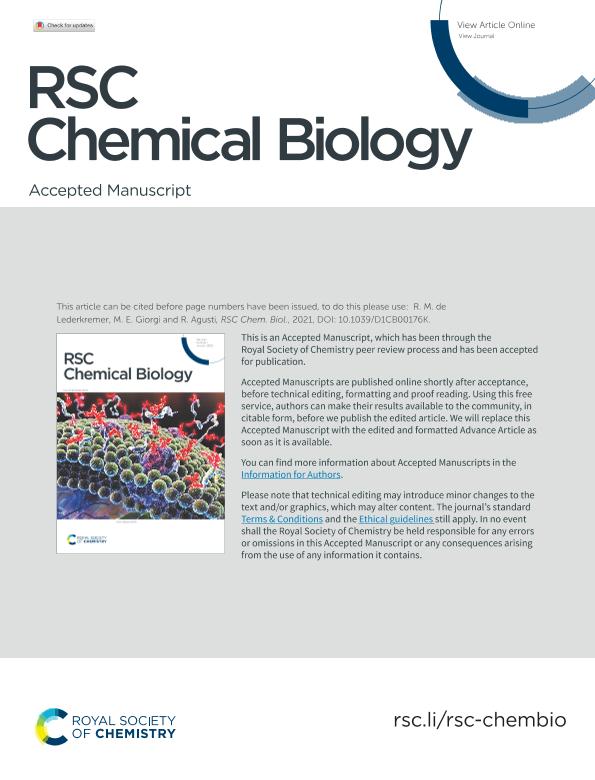Mostrar el registro sencillo del ítem
dc.contributor.author
De Lederkremer, Rosa M.
dc.contributor.author
Giorgi, María Eugenia

dc.contributor.author
Agusti, Rosalia

dc.date.available
2022-10-13T14:22:19Z
dc.date.issued
2021-11
dc.identifier.citation
De Lederkremer, Rosa M.; Giorgi, María Eugenia; Agusti, Rosalia; Trans-sialylation: a strategy used to incorporate sialic acid into oligosaccharides; Royal Society of Chemistry; RSC Chemical Biology; 3; 2; 11-2021; 121-139
dc.identifier.issn
2633-0679
dc.identifier.uri
http://hdl.handle.net/11336/172991
dc.description.abstract
Sialic acid, as a component of cell surface glycoconjugates, plays a crucial role in recognition events. Efficient synthetic methods are necessary for the supply of sialosides in enough quantities for biochemical and immunological studies. Enzymatic glycosylations obviate the steps of protection and deprotection of the constituent monosaccharides required in a chemical synthesis. Sialyl transferases with CMP-Neu5Ac as an activated donor were used for the construction of α2-3 or α2-6 linkages to terminal galactose or N-acetylgalactosamine units. trans-Sialidases may transfer sialic acid from a sialyl glycoside to a suitable acceptor and specifically construct a Siaα2-3Galp linkage. The trans-sialidase of Trypanosoma cruzi (TcTS), which fulfills an important role in the pathogenicity of the parasite, is the most studied one. The recombinant enzyme was used for the sialylation of β-galactosyl oligosaccharides. One of the main advantages of trans-sialylation is that it circumvents the use of the high energy nucleotide. Easily available glycoproteins with a high content of sialic acid such as fetuin and bovine κ-casein-derived glycomacropeptide (GMP) have been used as donor substrates. Here we review the trans-sialidase from various microorganisms and describe their application for the synthesis of sialooligosaccharides.
dc.format
application/pdf
dc.language.iso
eng
dc.publisher
Royal Society of Chemistry

dc.rights
info:eu-repo/semantics/openAccess
dc.rights.uri
https://creativecommons.org/licenses/by-nc/2.5/ar/
dc.subject
SIALIC ACID
dc.subject
TRANS-SIALIDASE
dc.subject
SIALOOLIGOSACCHARIDES
dc.subject
CARBOHYDRATOS
dc.subject.classification
Química Orgánica

dc.subject.classification
Ciencias Químicas

dc.subject.classification
CIENCIAS NATURALES Y EXACTAS

dc.title
Trans-sialylation: a strategy used to incorporate sialic acid into oligosaccharides
dc.type
info:eu-repo/semantics/article
dc.type
info:ar-repo/semantics/artículo
dc.type
info:eu-repo/semantics/publishedVersion
dc.date.updated
2022-09-20T21:11:54Z
dc.journal.volume
3
dc.journal.number
2
dc.journal.pagination
121-139
dc.journal.pais
Reino Unido

dc.journal.ciudad
Londres
dc.description.fil
Fil: De Lederkremer, Rosa M.. Consejo Nacional de Investigaciones Científicas y Técnicas. Oficina de Coordinación Administrativa Ciudad Universitaria. Centro de Investigaciones en Hidratos de Carbono. Universidad de Buenos Aires. Facultad de Ciencias Exactas y Naturales. Centro de Investigaciones en Hidratos de Carbono; Argentina
dc.description.fil
Fil: Giorgi, María Eugenia. Consejo Nacional de Investigaciones Científicas y Técnicas. Oficina de Coordinación Administrativa Ciudad Universitaria. Centro de Investigaciones en Hidratos de Carbono. Universidad de Buenos Aires. Facultad de Ciencias Exactas y Naturales. Centro de Investigaciones en Hidratos de Carbono; Argentina
dc.description.fil
Fil: Agusti, Rosalia. Consejo Nacional de Investigaciones Científicas y Técnicas. Oficina de Coordinación Administrativa Ciudad Universitaria. Centro de Investigaciones en Hidratos de Carbono. Universidad de Buenos Aires. Facultad de Ciencias Exactas y Naturales. Centro de Investigaciones en Hidratos de Carbono; Argentina
dc.journal.title
RSC Chemical Biology
dc.relation.alternativeid
info:eu-repo/semantics/altIdentifier/doi/http://dx.doi.org/10.1039/D1CB00176K
Archivos asociados
